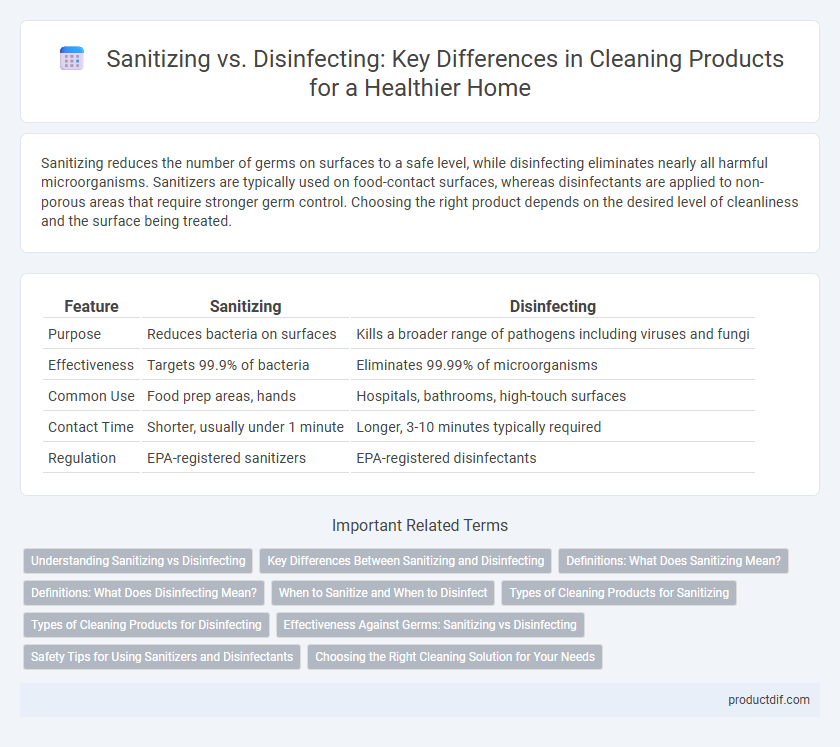Sanitizing reduces the number of germs on surfaces to a safe level, while disinfecting eliminates nearly all harmful microorganisms. Sanitizers are typically used on food-contact surfaces, whereas disinfectants are applied to non-porous areas that require stronger germ control. Choosing the right product depends on the desired level of cleanliness and the surface being treated.
Table of Comparison
| Feature | Sanitizing | Disinfecting |
|---|---|---|
| Purpose | Reduces bacteria on surfaces | Kills a broader range of pathogens including viruses and fungi |
| Effectiveness | Targets 99.9% of bacteria | Eliminates 99.99% of microorganisms |
| Common Use | Food prep areas, hands | Hospitals, bathrooms, high-touch surfaces |
| Contact Time | Shorter, usually under 1 minute | Longer, 3-10 minutes typically required |
| Regulation | EPA-registered sanitizers | EPA-registered disinfectants |
Understanding Sanitizing vs Disinfecting
Sanitizing reduces the number of germs on surfaces to a safe level as judged by public health standards, primarily targeting bacteria and some viruses. Disinfecting involves using stronger chemicals to kill nearly all pathogens on a surface, including bacteria, viruses, and fungi, offering a more comprehensive level of cleanliness. Understanding the difference helps in selecting the appropriate product based on the required cleanliness and the environment, such as routine cleaning versus infection control in healthcare settings.
Key Differences Between Sanitizing and Disinfecting
Sanitizing reduces bacteria on surfaces to a safe level as determined by public health standards, primarily targeting germs that cause illness. Disinfecting destroys or inactivates a broader range of pathogens, including viruses and fungi, making it more effective for high-risk areas like hospitals. The key difference lies in the extent and spectrum of microbial elimination, with disinfecting offering a higher level of microbial control compared to sanitizing.
Definitions: What Does Sanitizing Mean?
Sanitizing refers to the process of reducing the number of bacteria on surfaces to a safe level, as determined by public health standards. This is achieved by using cleaning products that lower microbial presence but may not eliminate all viruses or fungi. Sanitizing is commonly applied in environments like kitchens and food preparation areas to maintain hygiene and prevent bacterial contamination.
Definitions: What Does Disinfecting Mean?
Disinfecting involves using chemical agents to eliminate or kill harmful microorganisms such as bacteria, viruses, and fungi on surfaces, reducing the risk of infection. This process targets pathogens more aggressively than sanitizing, ensuring a higher level of cleanliness in critical areas. Effective disinfectants often contain ingredients like bleach, alcohol, or quaternary ammonium compounds to achieve microbial eradication.
When to Sanitize and When to Disinfect
Sanitizing is ideal for routine cleaning of surfaces that come into frequent contact with hands, such as kitchen counters and dining tables, to reduce germs to a safe level. Disinfecting is necessary for areas exposed to harmful pathogens or illness, like bathrooms or after someone has been sick, as it kills a higher percentage of bacteria and viruses. Choose sanitizing for everyday maintenance and disinfecting for high-risk contamination to ensure proper hygiene.
Types of Cleaning Products for Sanitizing
Sanitizing cleaning products primarily include sprays, wipes, and solutions containing lower concentrations of antimicrobial agents such as quaternary ammonium compounds and alcohols, designed to reduce bacteria on surfaces to safe levels. These products are often used in kitchens, food preparation areas, and schools where moderate germ control is required without damaging surfaces. Unlike disinfectants, sanitizers focus on controlling bacteria rather than eliminating all pathogens, making them suitable for frequent use on non-porous surfaces.
Types of Cleaning Products for Disinfecting
Disinfecting cleaning products include bleach solutions, alcohol-based sprays with at least 70% alcohol, and quaternary ammonium compounds (quats), all designed to kill bacteria, viruses, and fungi on surfaces. EPA-registered disinfectants offer proven efficacy against pathogens such as SARS-CoV-2, influenza, and E. coli, making them essential for infection control in healthcare and household environments. Selecting the appropriate disinfectant depends on surface compatibility, contact time, and target microorganisms to ensure effective pathogen elimination.
Effectiveness Against Germs: Sanitizing vs Disinfecting
Sanitizing reduces the number of germs on surfaces to a safer level, targeting primarily bacteria, while disinfecting eliminates a broader range of pathogens, including viruses and fungi, achieving a higher level of microbial kill. Disinfectants contain stronger chemical agents such as bleach, quaternary ammonium compounds, or hydrogen peroxide, making them more effective for critical environments like hospitals. Sanitizers are suitable for food-contact surfaces and everyday use where complete eradication of all microorganisms is not mandatory.
Safety Tips for Using Sanitizers and Disinfectants
Using sanitizers and disinfectants requires careful adherence to safety guidelines to prevent health risks and ensure effectiveness. Always read and follow the manufacturer's instructions, use gloves and ensure proper ventilation during application, and avoid mixing products, especially those containing bleach or ammonia. Store these chemicals in a secure place away from children and pets to minimize accidental exposure and poisoning hazards.
Choosing the Right Cleaning Solution for Your Needs
Sanitizing reduces the number of bacteria to a safe level, primarily targeting surfaces like kitchen counters and food preparation areas, while disinfecting kills a broader spectrum of pathogens, including viruses on high-touch surfaces such as doorknobs and bathroom fixtures. Choosing the right cleaning solution depends on the specific risk level and surface type; disinfectants are essential in healthcare settings or during illness outbreaks, whereas sanitizers suffice for routine cleaning in homes and restaurants. Understanding the difference ensures effective hygiene practices and helps prevent the spread of infectious agents in various environments.
Sanitizing vs Disinfecting Infographic

 productdif.com
productdif.com